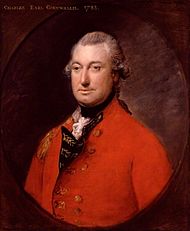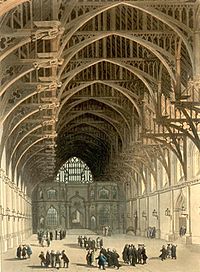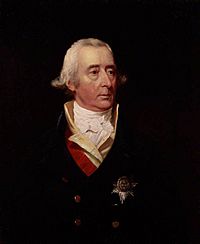Impeachment of Warren Hastings facts for kids
The impeachment of Warren Hastings was a famous trial that happened in the British Parliament. It lasted for seven years, from 1787 to 1795. Warren Hastings was the first governor-general of the Bengal region in India. He was accused of doing wrong things while he was in charge, like mismanaging money and being corrupt.
The main person leading the accusations against Hastings was Edmund Burke, a well-known politician. This trial became a big discussion about how the East India Company should rule India. It was also about whether Britain should have absolute power over the people they colonized or if they should respect their rights. Even though the trial was very long, Warren Hastings was found not guilty of almost all the charges. It is known as one of the longest political trials in British history.
Contents
Why the Trial Happened
Hastings Becomes Governor-General
Warren Hastings was born in 1732. He spent most of his adult life in India, starting as a clerk for the East India Company in 1750. Hastings became known for trying to govern British India using traditional Indian methods. This was different from many others who wanted to bring European laws and culture to India.
In 1773, he was made governor-general. This was a new job created by the British government to help manage British India better. The East India Company had grown a lot, from small trading posts to controlling large areas and many people.
Hastings' power was balanced by a group called the Calcutta Council. This council could stop his decisions. Hastings often had to work hard to get his supporters on the Council to agree with him.
Disagreements and War in India
Hastings soon faced opposition from the Council. His main enemy was Philip Francis, an Irish politician. Francis strongly disliked Hastings and believed his policies were selfish and harmful. Other Council members agreed with Francis. Their rivalry was so strong that they even fought a duel in 1780, where Francis was injured.
In 1781, Francis went back to Britain. There, he started raising questions about Hastings' actions. Many important politicians who were against the government supported Francis.
Around this time, Hyder Ali, the ruler of Mysore, started a war with the East India Company. This happened after British forces captured a French port called Mahé. Hyder Ali used Britain's involvement in the American War of Independence to his advantage. He also had support from French forces. Hyder Ali had early successes, even threatening the city of Madras.
However, the British commander Eyre Coote arrived with more soldiers. He defeated Hyder's army in several battles. The war ended in 1784 with the Treaty of Mangalore. This treaty mostly returned things to how they were before the war. Even so, Britain's position in India had been in great danger.
This war made people question how the Company's leaders in India were managing things. It helped fuel the growing campaign against Hastings in London.
First Accusations Against Hastings
The East India Company had already faced scandals in the 1760s and 1770s. Wealthy officials who returned to Britain from India were often unpopular. Because of this, the criticisms from Francis and others led to a general feeling that the 1773 India Act was not enough to control the Company's problems. The issue of India became a big political debate again.
In 1784, the new government led by William Pitt passed a new law called Pitt's India Act. This law created a Board of Control to help manage India better.
Hastings was personally attacked by Charles James Fox during a debate about India. When Pitt introduced his own law, he didn't mention Hastings at all. This was seen as a sign that Pitt didn't trust Hastings. Pitt also criticized the Company, saying that recent wars in India had been wasteful. Hastings was very upset by this, as he admired Pitt.
By now, Hastings wanted to resign and go home. He wanted more freedom to make decisions as Governor-General, but this was unlikely to happen. He handed over his duties to John MacPherson until a permanent replacement was found.
Hastings Returns to Britain

Hastings sailed home on February 6, 1785, and arrived in Britain in June. During his trip, he wrote a defense of his actions called The State of Bengal. He gave it to Henry Dundas. Hastings expected to face some criticism but thought it would stop once he was there to defend himself.
At first, things seemed fine. He met King George III and received a unanimous thank you vote from the East India Company directors. Hastings even hoped to be given a special title. However, in Parliament, Edmund Burke announced that he would "make a motion respecting the conduct of a gentleman just returned from India."
In early 1786, Burke began his first move. He questioned Hastings' role in the Maratha War. These attacks were mostly made by politicians who were against William Pitt's government. Pitt and other ministers defended Hastings. They said he had saved the British Empire in Asia.
Philip Francis made eleven specific charges against Hastings, and more followed. These charges covered different topics, like the Rohilla War, the execution of Nanda-Kumar, and Hastings' treatment of the Rajas of Benares Chait Singh. Pitt generally defended Hastings, but he said Hastings' punishment of the Rajah was too much. After this, a motion against Hastings passed in the House of Commons by a vote of 119 to 79.
Because Pitt didn't fully support Hastings, his opponents pushed harder. The situation quickly got worse for Hastings. It became clear he was going to face an impeachment trial. Hastings hired Edward Law, 1st Baron Ellenborough to defend him. On May 21, 1787, Hastings was arrested and taken to the House of Lords to hear the charges.
Hastings was to be tried in the House of Lords by a special committee. Impeachment was a rare way to try high-ranking public officials.
The Impeachment Trial
Trial Begins
Hastings' trial started on February 13, 1788. It took place in Westminster Hall, a large and important building. Members of the House of Commons sat on Hastings' right, and the Lords sat on his left. A large audience, including royalty, watched from special boxes.
The trial began with a very long speech by Edmund Burke. He spoke for four days, covering all the charges against Hastings. While Burke took the trial very seriously, many spectators treated it like a social event. Hastings himself later said that for the first half hour, he was amazed by Burke's speech and felt like the most guilty person on Earth.
Hastings was allowed to go free on bail. This was despite Burke suggesting he might run away with the money he supposedly stole from India. More speeches were made in the following weeks by other important politicians like Richard Brinsley Sheridan and Charles James Fox. In total, there were nineteen members on the committee leading the impeachment.
Public Opinion Changes

Even though the trial started with a lot of excitement, public interest began to fade. This happened as it dragged on for months and years. Other big events, especially the French Revolution starting in 1789, took over the news. Sheridan, one of the people who started the trial, even complained that he was "heartily tired of the Hastings trial."
As the trial continued, public feelings about Hastings also started to change. At first, the newspapers mostly showed Hastings as guilty. But doubts began to grow. People started to think less favorably of his accusers. In one cartoon, Hastings was shown as the "Saviour of India" being attacked by bandits who looked like Burke and Fox.
A big help for Hastings' defense came on April 9, 1794. Lord Cornwallis, who had replaced Hastings as Governor-General, gave his testimony. Cornwallis had recently returned from India. He said that Hastings' actions had not harmed Britain's reputation. He also noted that Hastings was very popular with the people in India. When asked if he had found any reason to question Hastings' character, Cornwallis replied, "never."
Another setback for the prosecution came from William Larkins, the former chief accountant of Bengal. The accusers had hoped he would reveal widespread corruption. But he denied that Hastings had taken any illegal money and defended his actions. Many other people also came forward to speak well of Hastings' character. Burke's final speech against the defense lasted nine days, from late May to mid-June 1794.
The Verdict
On April 23, 1795, the Lord Chancellor Lord Loughborough announced the verdict. A third of the Lords who had been there at the start of the trial had since died. Only twenty-nine of the remaining Lords had heard enough evidence to be allowed to vote.
Loughborough asked each of the Lords sixteen questions about the individual charges. On most charges, Hastings was found not guilty by everyone. On three questions, five or six Lords voted guilty. But Hastings was still easily cleared by a majority vote. This overwhelming verdict had been expected for some time and was not a surprise.
Burke, who had spent a lot of time and energy on the prosecution, was frustrated that the impeachment failed. He had warned the Lords that it would be "to the perpetual infamy" of the House if they voted to acquit Hastings. Burke remained convinced of Hastings' guilt until he died in 1797.
What Happened Next

The impeachment trial left Hastings in serious financial trouble. He had debts of £70,000. Unlike many other officials in India, he had not become very rich. He had to pay for his legal defense, which cost about £71,000, from his own money.
Hastings asked the British government for financial help. Eventually, the East India Company gave him a loan of £50,000 and a pension of £4,000 a year.
Although this didn't solve all his money problems, Hastings was finally able to buy back his family's traditional estate of Daylesford in Gloucestershire. This estate had been lost by his family in an earlier generation. Hastings did not hold any more public jobs. However, he was seen as an expert on Indian matters. In 1812, he was asked to give evidence to Parliament about India. After he finished speaking, all the members stood up. This was a very rare act of respect for anyone who was not part of the royal family.
Hastings' successors as Governor-General, starting with Lord Cornwallis, were given much wider powers. These were the powers Hastings had wanted when he was in Calcutta. Pitt's India Act moved much of the control over India away from the East India Company directors. Instead, a new political Board of Control in London took over.
Hastings was overwhelmingly found not guilty. Many people who had worked in India praised him. This has made people wonder why Hastings, who seemed to have served the company well, was put on trial in the first place. Several things might have played a part, including political rivalries. However, Pitt, who was in power, also supported the impeachment at one point.
There has been a lot of focus on Pitt's role. Especially his sudden decision to stop fully supporting Hastings in 1786. This encouraged Hastings' opponents to continue the case. It's possible that Pitt thought he might be accused of protecting a criminal for political reasons. Interestingly, Henry Dundas himself was later impeached in 1806. He was also found not guilty in what was the last impeachment trial in Britain.
Images for kids









